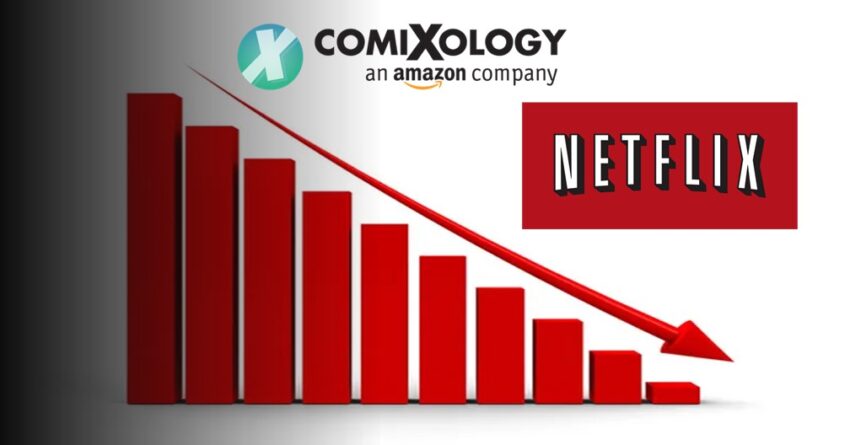If you’re keeping up with what’s happening in the world of digital comics, you’ve already heard the news. ComiXology announced a massive round of layoffs on their already struggling digital comics platform. Struggling as in “it doesn’t work as well after it merged with the Kindle reader.” Who could have seen this coming? Well, everybody.

Let’s take a look at the facts, courtesy of Publisher’s Weekly.
As part of Amazon’s plan to cut 18,000 positions, an number of Comixology staffers were laid off on Wednesday, January 18… A mix of supply chain delays, inflation and labor shortages caused by the Covid-19 pandemic has been rough on the company’s store operations, the memo cited.”
Amazon Layoffs Hit Comixology Staff – Publisher’s Weekly, Jan. 20, 2023
In other words, Amazon (owner of ComiXology) cited a number of external factors that led to the decision. It’s anyone’s guess how accurate that explanation really is, but citing “COVID” and “supply chain delays” for a digital application immediately raises red flags. You’re not delivering a physical product, and developers can work from home as readily as they can from the office. Feel free to draw your own conclusions.
What’s interesting about this news is the familiar parallels from recent announcements related to Netflix, the default streaming service up until the last year or so.
“Key Points
Netflix lays off 300 more employees as revenue growth slows – CNBC.com, June 23, 2022
- Netflix is laying off around 300 employees across the company, CNBC confirmed Thursday.
- The cuts come about a month after the streaming company eliminated about 150 positions in the wake of its first subscriber loss in a decade.
- Netflix had warned investors in April that it would be pulling back on some of its spending growth over the next two years.”
Netflix officials didn’t provide as many specifics about the external factors surrounding the decision, but they were clear that subscriber growth and revenue weren’t keeping up with costs.
What is clear, however, is that neither ComiXology nor Netflix was cashflow positive enough to stand up to economic pressure, despite the fact that both services were once considered the default digital app in their respective industries. If you take a look at their inventory, the reasons behind that lack of cash flow become clear very quickly.
Netflix and ComiXology are both almost entirely reliant on outside creators for their livelihood, and the same is true in the reverse… or it used to be. Once upon a time, if you wanted to get a non-pirated version of a Marvel or DC comic, ComiXology was your only option. Once upon a time, Netflix was the only place to stream movies over the Internet wherever and whenever you wanted. They were the trailblazers, and they milked that status for as long as possible.
But reality comes knocking for all of us eventually. What one can do, another will find a way to do better, and if the trailblazer doesn’t keep trailblazing, the competitors will.
As of this writing, Marvel has its own digital app that functions just as well as ComiXology’s. The same could be said for DC. What did ComiXology do with their #1 status while they held all the cards in the digital comics space? Not much of note. ComiXology provided a platform for small indie creators that have no hope of attracting a large audience and enabled convenient hooks to buy physical comics from Amazon. That’s about it.
Netflix is battling to survive in a now-crowded streaming market with the likes of Amazon Video, HBO Max, Paramount+, and more. Every major studio has its own streaming service or is toying with creating one. What did Netflix do with its dominance in the streaming space for all those years? They flooded their inventory with niche television shows and films that could only be attractive to an admittedly tiny audience. Even with mainstream hits like Stranger Things and Tim Burton’s Wednesday, those hit offerings are brief, few, and very far in between.
What’s the lesson? Netflix and ComiXology are both victims of complacency and laziness. When you’re a digital service that specializes in centralizing other creators’ works, the dominance you enjoy is fleeting. If Netflix and ComiXology wanted to hold on to their dominant positions, they needed to pursue original content with broad appeal that they would exclusively control much sooner and more aggressively. Neither company is doomed (yet), but a turnaround is infinitely harder now than it would have been ten or even five years ago.
What’s the lesson for everyone else in comics? Stay hungry because a top spot is never permanent, continue to improve and bring value, and prioritize owning your own stuff. You’ll be glad you did.
We hope you found this article interesting. Come back for more reviews, previews, and opinions on comics, and don’t forget to follow us on social media:
If you’re interested in this creator’s works, remember to let your Local Comic Shop know to find more of their work for you. They would appreciate the call, and so would we.
Click here to find your Local Comic Shop: www.ComicShopLocator.com
As an Amazon Associate, we earn revenue from qualifying purchases to help fund this site. Links to Blu-Rays, DVDs, Books, Movies, and more contained in this article are affiliate links. Please consider purchasing if you find something interesting, and thank you for your support.

